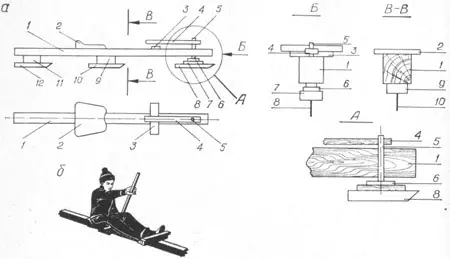In this review of our site, close attention will be paid to the special training systems and technical devices that modern rower kayaker.
As is known rowing is a sport that requires from the athlete not only great physical strength, controlled breathing, enormous endurance, but also competent, technology polished over the years. An incorrect movement, and the resulting lost seconds, can cost the athlete a prize place. It is for this reason that the technique of movements should be impeccable, and every professional kayaker is obliged to bring it to the peak of perfection. They will help him with this:
- trainer,
- daily practice,
- as well as modern technical means designed to hone the skill to its possible limit...
Well, let's take a closer look at these training devices...
Content- Training device for training kayakers.
- Training device for rowers.
- Training device for kayaking (for one athlete).
- Training combined device for kayaking (for two athletes).
Training device for training kayakers.
The device is intended for training rowers and kayakers on ice in winter and allows the rower to reproduce the movements of the arms and shoulder girdle similar to the movements when rowing a kayak. Exercising on the device develops a feeling equilibrium.
The whole system "rower - device" moves on two or three supports located on the same axis, coinciding with the direction of movement (Fig. 1). The main part of the device (Fig. 1, a) is made up of beam 1, on which a mini-kayak seat 2 and a special foot rest 3 are attached on top. Gaskets 9.11 are attached to the lower surface of the beam, to which, in turn, fixed runners are attached or blades 10, 12. And also the front rotating skid 8. It is attached to the gasket 7 connected to the flange 6 of the axis 5. A tiller 4 is installed on the top of the axis.
It is best to place the seat above the ice at a height of 100…150 mm. The rower sits on the seat, rests his feet, so that the end of the tiller is between the toes (Fig. 1.6). To move the device on ice, a device in the form of a kayak oar is used, the blades of which are replaced with sharp steel tips. The rower alternately pushes off the ice with the indicated oar on the left and right sides, similar to how it is done when rowing a kayak.
Training device for rowers.
The device is used for general physical training, imitation of movements in rowing.
The device (Fig. 2) consists of a horizontal base 4, a movable seat 5, a U-shaped handle 1, articulated joints 2, footrests 3. The handle moves relative to the base. During training, the seat installed on the base makes a reciprocating movement. When the handle is moved, the links pivotally connected to the handle and the seat are set in motion. As a result, the seat moves back and forth.
Training device for kayaking (for one athlete).
Device in use to correct asymmetry in rowing and is intended for one athlete.
The device (Fig. 3) consists of a platform 1 with guide rollers 2, a movable slide 4 and a rod with handles 3. The platform is made of a board 40...50 mm thick, 300 mm wide and has two guide grooves along which the movable slide moves. Hooks for rods are attached to the sides on the front of the platform. The length of the device is at least 2 m.
On the device, movement occurs only with the help of the efforts of one rower: forward - due to the traction of a stationary cable, back - due to traction through a block device installed in front.
The device is designed to correct asymmetry in rowing (for two athletes).
The device (Fig. 4) consists of the following elements: seat 1, fixed slide 2, footrest 3, hooks for attaching rods 4, rods 5, handles 6, platforms with guide grooves 7. The length of the device is at least 3 m.
Movement on the device occurs as follows. A rower, sitting on a sled in a kayaker's position, pulls the cable with one hand. The same muscle group is involved in the work as in rowing a kayak. The rower sitting behind leans forward and, due to the work of the back muscles, returns the athlete sitting in front to the starting position, simulating rowing on boats.
Post Views: 116


